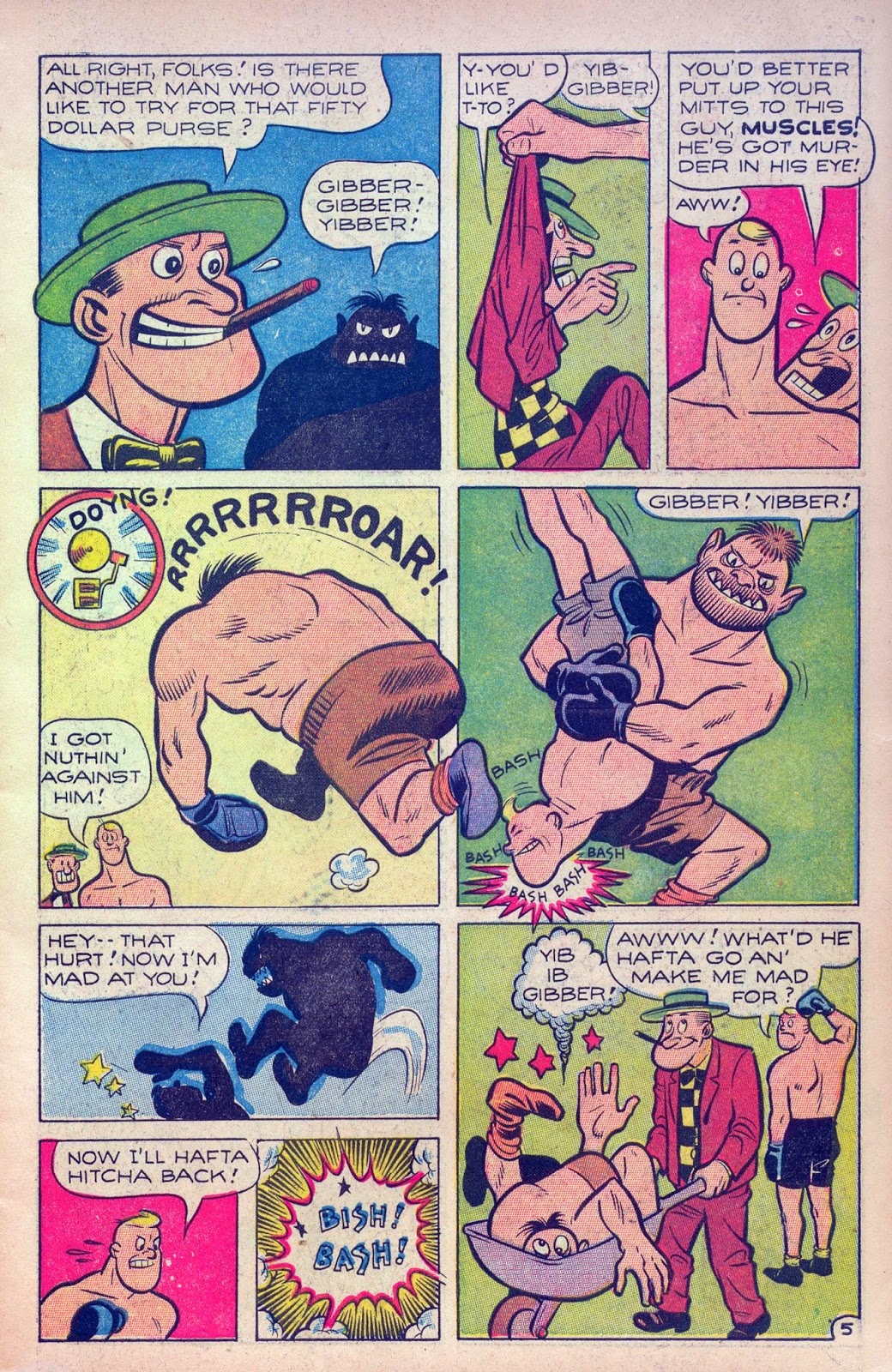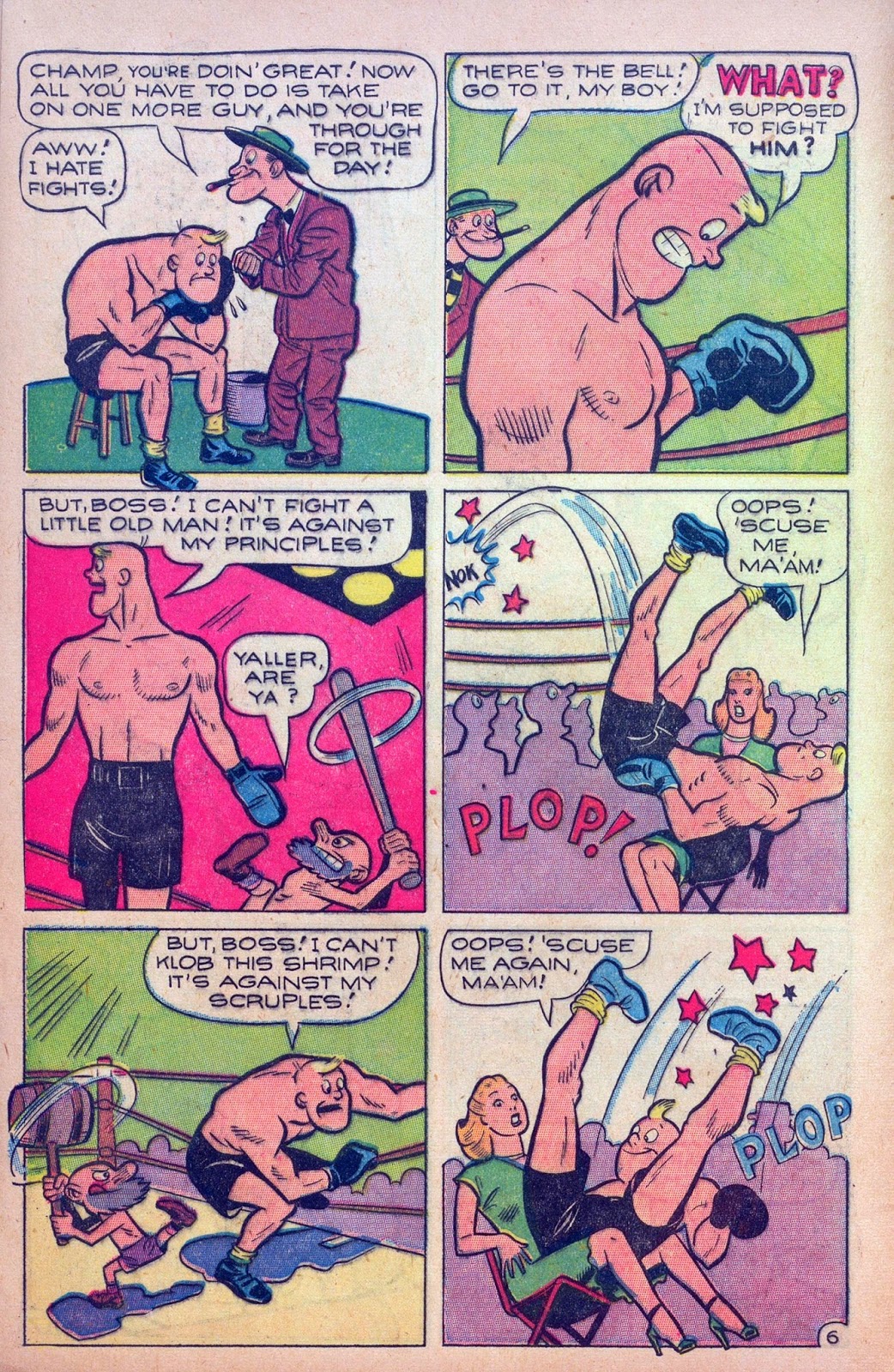Those few worthy items--a dust mote per each acre of bodily waste--keep some of us still obsessively digging, straining, and running to wash our hands as something of genuine merit is unearthed, hosed off, and examined.
The decade of shared digital comics scans on the Internet has liberated older comics from their former near-invisibility. Until, say, 2008, it was impossible for most people--save a few hard-core hoarders who had a head-start on the rest of us--to really grok how faceless and dull most American comic books really have been, since their inception.
A potential wealth of material awaits on such sites as The Digital Comic Museum and Comic Book Plus. Their scans are thoughtfully indexed by publisher, and in chronological publication order. Each day, new scans, some of them beautifully faithful to the printed source material, appear, gratis.
It's easy to take this ongoing phenom for granted. Most of this material is considered in the public domain--a stricture that removes almost all the efforts of major publishers of the 1930s through the present.
Thanks to the genuinely heroic efforts of the essential site More Than Heroes: Timely-Atlas Comics, we have immediate access to a conduit of hundreds of unauthorized scans of comics from the company that would eventually be known as Marvel. Its curator offers a weekly random bouquet of western, crime, teen, romance, humor, horror, SF and super-hero material, again organized by publication title and issue.
Paul Tumey and I have discussed the fascinating ups and downs of the Timely-Atlas-Marvel product here before. The company's output is the great middle-ground of American comic book history. Never a trailblazer, T-A-M was a shameless cash-in company. A trend might occur at D.C., E.C., Quality or other publishers. Before the ink was wet on the first issues of those companies' innovations, T-A-M would have a simulacra on the newsstands to sop up any leftover gravy.
.jpg)
Once said trend peaked, those cast-offs would be killed, and another topical title put in its place. This strategy helped the company tread water during the doldrums of the late 1950s, and allowed them to emerge as a major imprint in the '60s.
Certain artist-writers, looking for a place to blow off some steam, found an unlikely ally in the T-A-M (un)funny comics. Two of comics' best and most idiosyncratic creators--Basil Wolverton and Harvey Kurtzman--did stints with the company in the 1940s and '50s. Wolverton worked at T-A-M from the early 1940s 'til the mid-'50s; Kurtzman's work appears for about three years.
The cream of Kurtzman's work for T-A-M are his one-page "Hey Look!" strips. This series shows Kurtzman's development from promising tyro to master of absurd, graphically devastating metacomedy. Someday, someone will do a full-color reprint of the series, to replace the still-useful black and white (and way out-of-print) collection issued by Kitchen Sink Press in 1992.
Here's a particularly nice example of "Hey Look!" The page bristles with visual and comedic innovation, and shows the influence of "cartoon modern" sensibilities rampant in post-war animation, advertising and graphic design:
Kurtzman did a significant amount of other humor features for T-A-M--from ripoffs of "Blondie" to lively, adroit funny-animal material.
His learning curve is impressive, despite the quality of the stories themselves. When left to his own devices as a writer-artist--as in "Hey Look!"-- the results are often brilliant.
As a work-for-hire cartoonist, Kurtzman was professional and, like Dick Briefer, able to leave the imprint of his personality on the dullest of mundane work. But, as with Briefer, it's clear to see when Kurtzman's heart was not in his work.
Somewhere in-between "Rusty" and "Hey Look!" falls the lone episode of "Muscles Malone," from the first issue of the second version of Krazy Komics, published in 1948.(cover, seen at left, is decidedly not by HK)
No one would call "Muscles Malone" a narrative masterpiece. Kurtzman's cartooning, however, is eye-candy of the nth order. The vigor, aggression and expression of his posing, linework and layout--which eerily predicts the work of Ren and Stimpy auteur John Kricfalusi--is highly rewarding. It's much more than the slight story deserves, and it's possible Kurtzman wasn't too proud of it. He signed it with a humble HK, hidden in a blue star (part of a visual effect) on the splash page.
"Eustace Hayseed," one of several strips by Joseph Sulman that imitates Al Capp's work to a depressing degree, follows "Malone." The heart of a first-time browser immediately sinks, after the visual highs of Kurtzman's fluid foolery. Sulman, who also drew "Zatara the Magician" for D.C.'s Action Comics in the 1940s, was a leading agent in comics-shitmaking of the so-called Golden Age.
The sheer number of unskilled copyists of Capp, Crane, Raymond, Foster and Caniff in 1930s and '40s comics are among the medium's lowlights. Their work is a reminder that most mainstream comic book artists, past, present and future, are essentially cheerful plagiarists, brimming with enthusiasm, but with nothing personal or different to bring to the page. Their work is filler of the saddest stripe, and proof of the inherent cynicism of most comic book publishers.
"Eustace" is enough to make all but the bravest abandon hope. After a few stale pages of this bald-faced Capp-crap, it's a bracing pleasure to encounter the work of a true eccentric.
Basil Wolverton would have been familiar to T-A-M's more faithful readers, due to his long-running "Powerhouse Pepper" series, which appeared in various company humor anthologies, and in its own book--a sign of its apparent appeal and success.
Wolverton's "Pepper," a cross of Voltaire's Candide and E. C. Segar's Popeye (and seen here from the pages of 1945's Joker Comics #19), is shot through with a trademark linguistic quirk. Manic alliteration and internal rhymes, usually fused to a name, gives Wolverton's work a rhythm unique to the comics, period.
Self-reflective humor was another strong element of "Powerhouse," and its off-putting, utterly charming effect was seldom put to better use than in Wolverton's two efforts for the 1948 Krazy Komics.
As with "Hey Look!," this work shows one of the best aspects of Golden Age publisher cynicism: cartoonists with something unusual to say could express themselves loud, proud and clear--as long as their work was filler.
"Piston Pete - The Hotel Clerk" is one of Wolverton's most amusing screwball souffles. Loaded with puns, alliterations, wordplay and--most importantly--with the characters' cheerful self-awareness--this is low comedy meta-lunacy at its best. Read, McSneed...
Wolverton's mountain of chaotic-yet-droll komics seldom yielded a story as focused--and outright fun--as "Piston Pete." From the start, the reader never knows exactly where each succeeding panel will lead them.
Page nine is a hailstorm of offhanded inspiration. The first tier delivers a sub-par vaudeville joke, then assumes its reader will need a moment to laugh. If anything, the portrait of Blaine Payne, intended as a respite from the melee, proves far funnier--and more out of cloud-cuckoo-land--than anything else in the story. Capped by the author's admission that the first joke wasn't really funny, the tier is screwball gold.
Were the rest of the page filler, Wolverton could be easily forgiven. He's just warmed up. Hatch H. Hutch (of Hotch) proves his innocence to a determined cop by producing a copy of the very comic book we're reading.
Hutch points out some damning evidence of the villain's malfeasance, convinces the law, and then stops for a sidebar of gorgeous existential ponder:
This sort of self-reflective humor was nothing new. Animated cartoon directors of the 1930s and '40s had gone through these motions many times before. Wolverton makes something new of a potential trope with this beautiful moment of introspection.
Kurtzman is nowhere in sight in the next (and last) issue of Krazy Komics, but Wolverton wanders by with another jolt of jazzy jibberish in "Flap Flipflop - The Flying Flash."
This is more familiar Wolverton turf--the rough-house outdoor world of "Powerhouse Pepper," in which the environment becomes as much a character as the interchangeable sentient beings. It's no surprise that Pepper does a walk-on, on page seven, to help extricate Ice-Pick McNick from a bear-trap.
The droll parade of gags, rattling with wordplay, includes another bit of self-reference, in which Flap plugs the sub-par Timely feature "Tessie the Typist," in an apparent attempt to charm the editors.
Alas, it was a pass--Krazy Komics was killed without much ado. As an outlet for Wolverton's growing sense of the absurd, KK might have paved the way for an upswing in off-the-wall, unpredictable comic-book chaos.
Kurtzman and Wolverton were to meet again, with spectacular results, in the pages of Mad (in its comic-book and magazine incarnations), including the cover to its 11th issue, which remains one of the primal images of mid-century American pop culture. Could Krazy Komics have planted the seed of this image? If so, it probably didn't kare.
© 2014 Frank M. Young




































Very cool stuff
ReplyDelete